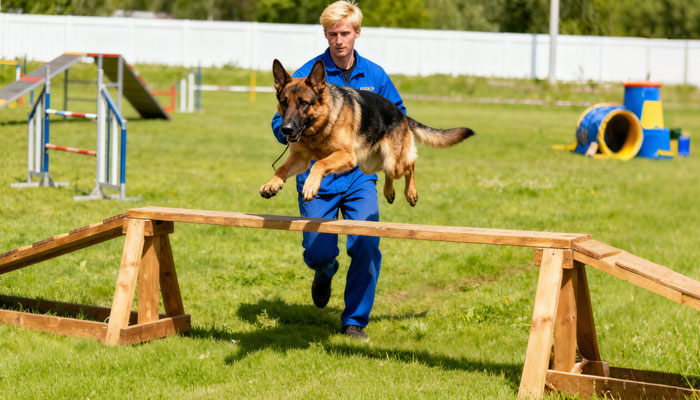Dog Training: 15 Common Mistakes to Avoid

When first getting a dog, they aren’t always easy to train. Throughout the dog training process, owners often need to adjust their teaching methods. So let’s take a look at these 15 expert-identified mistakes in dog training—what practices could inadvertently mislead your dog?
1. Core Principle: Never Follow “Come” with Punishment
Even without a reward, a dog will approach its owner after hearing “come.” However, if you call your dog over only to subject it to its most dreaded activity—like a bath—or even scold it, naturally, the next time you call, it won’t want to come near you. Therefore, in dog training, always reward your dog after calling “come.” This can be a treat, a toy, or simply petting it.
2. Taboo: Never Encourage Jumping Up
During dog training, dogs cannot distinguish whether the person they’re jumping on is a healthy young adult or a frail elderly person. If your dog has a habit of jumping up, use training to teach it to sit quietly and wait for guests to approach, or simply ignore it to make it understand that jumping up brings no benefits.
3. Misconception: Never scold your dog for potty training failures
During the critical potty training phase, methods like pressing a dog’s nose into urine or punishing it are actually harmful! This approach instills fear in the dog, undermining training effectiveness.
4. Key: Never Let Your Dog Lead During Walks
Walks are crucial training scenarios. If your dog charges ahead like a wild horse tugging the leash, stop immediately. Only resume walking once your dog halts and looks back at you. During training, reward your dog whenever it walks calmly at your pace to reinforce this behavior.
5. Point: Clearly Distinguish Between Going Out to Potty and Playing
In dog training, establish that going outside is solely for potty breaks, while playtime comes afterward. Otherwise, training may involve prolonged wandering before the dog relieves itself, causing frustration for the owner.
6. Principle: The Dog House (or Crate) Is Not a Punishment Space
In dog training, the dog house (or crate) should be a safe haven where your dog feels secure. Use it for meals and place favorite treats inside. If you turn this space into a punishment area during training, your dog will naturally avoid it.
7. Technique: Ignore Barking Dogs
During dog training, soothing or scolding a barking dog reinforces the habit. The effective approach is to ignore the barking. Only reward the dog once it has quieted down to help correct the behavior.
8. Details: Never Respond to Begging During Mealtime
Mealtime is part of dog training. If your dog begs under the table with pleading eyes while you eat, responding will reinforce the bad habit that proximity equals food. Train your dog to return to its bed instead, rewarding it with treats for obeying.
9. Caution: Never Leave Food in the Kitchen or Anywhere Your Dog Can Easily Access
During dog training, dogs remember food locations well. Knowing the kitchen holds treats, they may scavenge when you’re away. Therefore, in dog training, always reward your dog outside the kitchen to discourage kitchen access.
10. Fundamentals: Address the root cause of problem behaviors—stimulation or lack of exercise.
Dogs require outlets for energy. Without adequate release, they may exhibit disruptive behaviors. Therefore, prioritize opportunities for exercise during training to prevent problem behaviors.
11.Advanced: Gradually Reduce Reward Frequency
During early training, treats can motivate obedience, but reliance on them must decrease over time. Otherwise, the dog will only obey when treats are present. Gradually reduce reward frequency so the dog obeys commands reliably without food incentives.
12. Key Point: Teach Distinction Between Permitted and Forbidden Objects
Puppies teething and chewing objects is a common challenge in dog training. When your dog bites something it shouldn’t, redirect its attention during training by offering an appropriate chew toy as an alternative. Reward the dog when it chews the toy to reinforce this correct behavior.
13.Boundary: Never allow it to develop a habit of biting people
If a puppy’s habit of biting hands affectionately isn’t corrected during training, it becomes dangerous as an adult. If the dog bites you painfully while playing, yell “Ow!” and immediately walk away to make it understand biting people is unacceptable.
14. Response: Never Punish Aggressive Barking
When dogs feel threatened or fearful, they may emit aggressive barks as a form of emotional expression. In such situations, simply move the dog to another location without punishment to avoid intensifying its fear.
15. 15. Special Situation: Handling Urinary Incontinence from Over-Excitement
It’s common for dogs to urinate when overly excited upon seeing their owner return home. In such cases, petting or talking to the dog may reinforce the habit. It’s best to ignore it until it calms down. Scolding may have the opposite effect.
admin
-
Sale!

Washable Pet Cooling Pad for Cats and Dogs
$10.99Original price was: $10.99.$9.99Current price is: $9.99. This product has multiple variants. The options may be chosen on the product page -
Sale!

Washable Cat Window Hammock Cooling Bed
$23.99Original price was: $23.99.$22.99Current price is: $22.99. -
Sale!

Tropical Amphibian Rainforest Tank, Lizard Cage
$38.99Original price was: $38.99.$36.99Current price is: $36.99. -
Sale!

Silent 4-in-1 Waterproof Charging Dog Hair Trimmer
$49.88Original price was: $49.88.$47.99Current price is: $47.99.